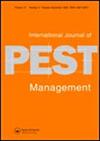Biological control potentials of Chrysoperla zastrowi sillemi (Neuroptera: Chrysopidae) against Bemisia tabaci (Hemiptera: Aleyrodidae) on polyhouse grown parthenocarpic cucumber in North-Western India
IF 1.1
4区 农林科学
Q3 ENTOMOLOGY
引用次数: 0
Abstract
AbstractThe silver leaf whitefly, Bemisia tabaci Gennadius (Hemiptera: Aleyrodidae), stands out as a highly destructive insect in temperate, tropical, and subtropical regions, inflicting extensive damage to agricultural crops worldwide. Its impact resonates in India, where it has emerged as a formidable pest. Moreover, the excessive use of chemically-derived pesticides has led to the emergence of insect-resistant strains, resulting in environmental pollution and endangering human health. The use of natural enemies is a sustainable and environmentally safe alternative management tactic. The predation potential of green lacewing, Chrysoperla zastrowi sillemi Esben-Peterson (Neuroptera: Chrysopidae) on eggs, nymphs and adults of B. tabaci infesting parthenocarpic cucumber grown under polyhouse has been examined here. On cucumber plants, three releases of 2nd instar C. zastrowi sillemi larvae (at one, two and three larvae/plant) were made at 7 days intervals. The release of three larvae/plant resulted in significantly higher predation rate on whitefly population (58.6% on egg, 61.0% on nymph and 32.3% on adult stage of the whitefly) than two or one green lacewing larvae/plant (56.3% on egg, 58.3% on nymph and 30.4% on adult stage of the whitefly & 49.9% on egg, 51.0% on nymph and 24.6% on adult stage of the whitefly, respectively). Significantly higher yields of cucumber were recorded from plots with the release rate of three larvae per plant (2047.9 g/plant). Augmentative biological control of B. tabaci under polyhouse conditions with three weekly releases of 2nd instar C. zastrowi sillemi larvae at three larvae per plant can effectively manage whitefly infestation on parthenocarpic cucumber under polyhouse condition.Keywords: Biological controlmarketable fruit yieldpredation efficiencyprotected structuresvegetable cropwhitefly AcknowledgementsThe authors are grateful to the Dr. Pardeep Kumar Chhuneja, Professor of Entomology and Head, Department of Entomology, Punjab Agricultural University, Ludhiana, India, for providing infrastructure and necessary facilities during the study. The facilities provided by Biological Control Section, Department of Entomology, Punjab Agricultural University, Ludhiana, for helping in the identification and rearing of whitefly and green lacewing cultures are duly acknowledged.Disclosure statementNo potential conflict of interest was reported by the authors.印度西北地区单作黄瓜绿茧蝶对烟粉虱的生物防效研究
摘要银叶粉虱(半翅目:烟粉虱科)是温带、热带和亚热带地区极具破坏性的昆虫,对世界各地的农作物造成了广泛的危害。它的影响在印度引起了共鸣,在那里它已经成为一种可怕的害虫。此外,过度使用化学衍生农药导致出现抗虫菌株,造成环境污染,危害人类健康。使用天敌是一种可持续的、对环境安全的替代管理策略。本文研究了绿草蛉(Chrysoperla zastrowi sillemi esbeni - peterson,神经翅目:草蛉科)对单性黄瓜卵、若虫和成虫的捕食潜力。在黄瓜植株上,每隔7 d分别释放1、2、3个2龄小蠹幼虫。3株绿草蛉幼虫对白蝇种群的捕食率(对卵58.6%,对若虫61.0%,对成虫32.3%)显著高于2株或1株绿草蛉幼虫对卵56.3%,对若虫58.3%,对成虫30.4%;对卵49.9%,对若虫51.0%,对成虫24.6%)。每株释放3只幼虫(2047.9 g/株)的小区黄瓜产量显著提高。采用每株3只、每周3次放生2龄烟粉虱幼虫的强化生物防治方法,可有效防治单性黄瓜白蝇侵染。关键词:生物防治,可销售水果产量,捕食效率,保护结构,蔬菜作物,粉虱。作者感谢印度旁遮普农业大学昆虫学教授兼系主任Pardeep Kumar Chhuneja博士为研究提供了基础设施和必要的设施。卢迪亚纳旁遮普农业大学昆虫学系生物防治科为帮助鉴定和饲养粉虱和绿草蛉所提供的设施得到了适当的认可。披露声明作者未报告潜在的利益冲突。
本文章由计算机程序翻译,如有差异,请以英文原文为准。
求助全文
约1分钟内获得全文
求助全文
来源期刊
CiteScore
4.70
自引率
6.70%
发文量
74
审稿时长
>12 weeks
期刊介绍:
International Journal of Pest Management publishes original research papers and reviews concerned with pest management in the broad sense, covering the control of pests (invertebrates, vertebrates and weeds) and diseases of plants, fungi and their products – including biological control, varietal and cultural control, chemical controland interference methods.
The management of invasive species is of special interest. We also encourage submissions dealing with interactions of multiple pests such as arthropods and plant pathogens, pathogens and weeds or weeds and arthropods as well as those dealing with the indirect and direct effects of climate change on sustainable agricultural practices.

 求助内容:
求助内容: 应助结果提醒方式:
应助结果提醒方式:


